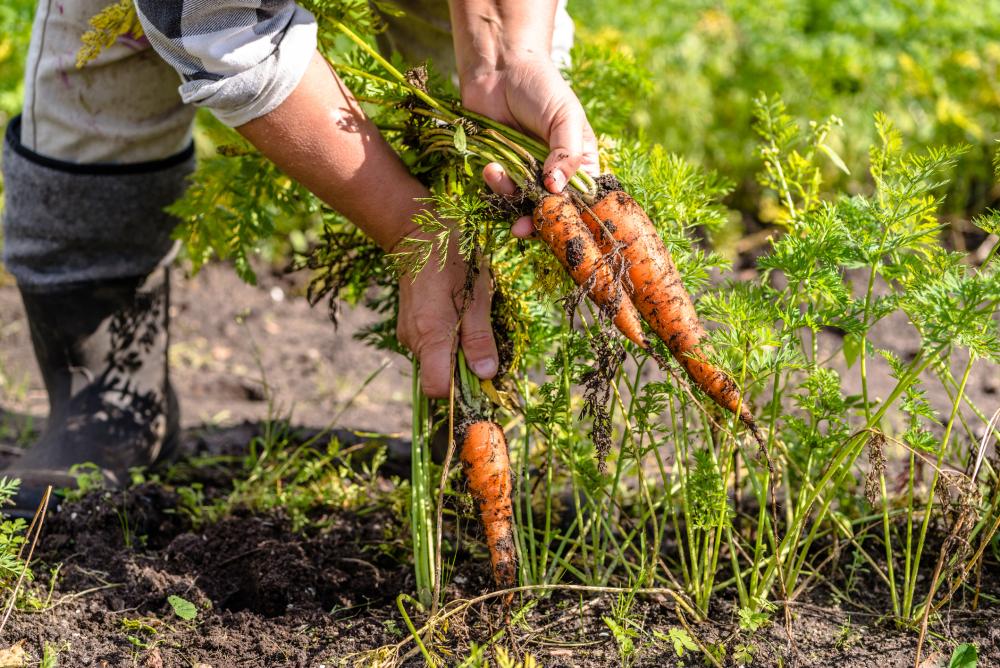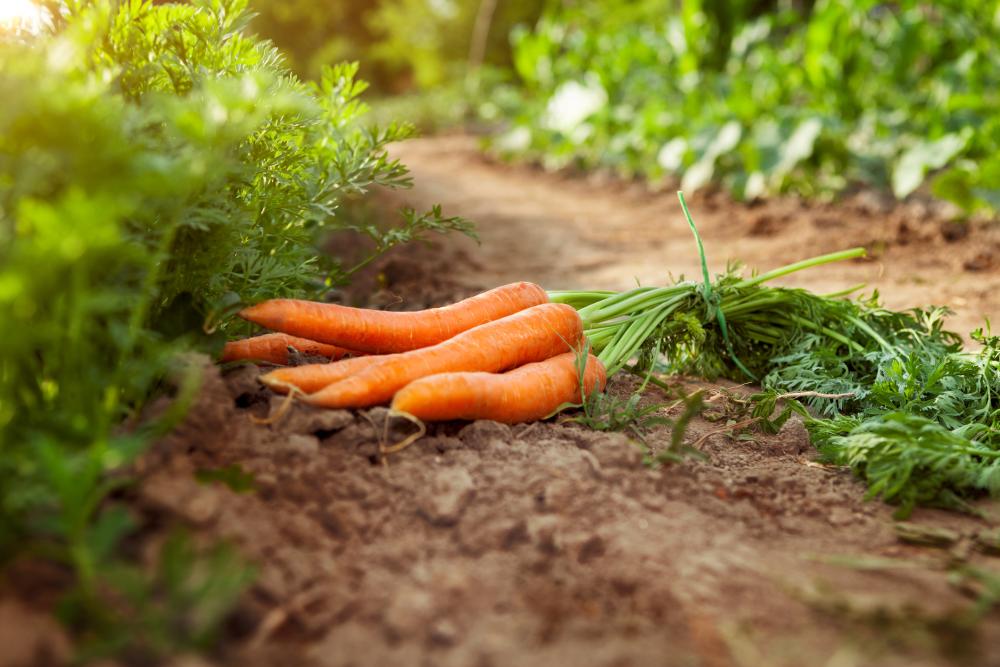Carrot Growing Problems And How To Fix Them
Carrots are sweet, succulent, and crisp veggies. The fresher they are, the tastier. This is why gardeners grow carrots of different types and varieties. There are purple carrots, white ones, orange, red, creamy, and all shades between. But as many gardeners soon discover, the carrots that grow at home are not as smooth or shapely as the ones you buy at the market.
Since carrot roots grow under the surface, anything can go wrong. The roots become deformed, get extra hairy, or just crack. Not to mention the other carrow growing problems such as carrots not developing, damping off, or catching a couple of diseases and fungal infections. This article lists the common carrow growing problems and how to fix them.
Carrots Not Developing
A common problem that gardeners complain about is the carrots not developing. After sowing the seeds and the first true leaves emerge, the seedling simply freezes in time and space. It doesn’t develop a root that penetrates the soil and fattens up underground. The leaves grow naturally, but no root materializes. And without a root, there’s no point in planting carrots at all. So why are the carrot plants refusing to develop roots?
- Temperature: Although the carrot seeds need temperatures between 55 to 75 degrees F to germinate, if the temperature of the soil goes above 75 degrees F, the root will not develop.
- Soil: Heavy soil is a natural obstacle for the roots. Despite the size and girth of the carrot root, it struggles to develop in clay or rocky soil.
- Spacing: Carrots need space to grow. By nature, they’re not competitive,e and the sensitive roots will stop developing if the plants are too dense in the patch or if they have to compete with weeds.
- Drought: Regular watering and moist soil are the keys to healthy carrot roots. Dry soil makes it hard for the root to grow and reach its full length and girth.
How to Fix it
Following the recommended best practices of carrot care and maintenance is the key to a successful carrot harvest. To encourage carrots to develop healthy and tasty roots, follow the tips.
- Plant carrot seeds as early in the spring as possible. That way, you’ll give the cool-weather veggie ample time to grow and develop roots before the weather gets too hot.
- If the afternoon sun scorches the carrot leaves and literally bakes the soil, consider planting the vegetable in partial shade.
- Amend the soil to make it more sandy and loose. You can also plant the carrots in raised beds if the soil is clay.
- After the first two sets of true leaves emerge, thin out the seedlings leaving between 2 to 4 inches of space between them.
- Remove weeds and debris regularly and keep the beds clean to avoid competition.
- Shallow watering is the key to keeping the soil moist at all times. Carrots need one inch of water per week, so don’t let the soil dry out.
Carrots Cracking
It’s no secret that the carrots that grow in your garden are nothing like the ones you buy at the supermarket. While commercial carrots are smooth, straight, and without a blemish, the ones you pull out of your garden soil are anything but. The most serious concern is when the carrots look cracked, as if they have been in a serious fight. Apart from looking uninviting, split carrots lack the flavor, sweetness, and taste that a whole carrot has.
The main two reasons that carrots crack in the soil are inadequate watering and fertilizing. Luckily, this serious problem is easy to fix. However, sometimes a few factors contribute to the problem and cause the carrots to crack in the soil without you even noticing. So how would you prevent this from happening?
How to Fix it
As with all carrot growing problems that are related to the environment surrounding the carrots, you’ll need to pay attention to the soil, temperature, and water. In the case of carrots cracking, fertilizers can be a contributing factor.
- Water the carrots regularly. Don’t let the top one inch of the soil go dry. When watering, sprinkle the plants shallowly to get the soil moist without overwatering it.
- Before sowing the seeds, check the soil and get a reading of the nitrogen deposits in the garden. If the nitrogen is too high, it could cause the roots to crack and become hairy.
- Don’t plant carrots in a spot where legumes grew before. Legumes fix the nitrogen in the soil.
- Remove rocks and debris from the soil since they could injure the roots and cause them to split up.
- Thin out the seedlings and leave between 2 to 4 inches between each plant.
Carrot Cotton Root Rot
Root rot is a serious problem for many plants and even more so for carrots. That’s because the root is the most important part of the carrot food-wise, so when something happens to that vital part, the whole plant is rendered useless.
The only you can tell that your carrot might have cotton root rot is if you look for the symptoms above the surface. You can’t dig the root up to inspect it, so if you find these symptoms, your carrots are infected.
- Leaves turning bronze and wilting.
- Stems become mushy before they wilt as well.
- In some cases, the leaves will remain on the plant although they become discolored.
- The plant dies, although the root remains healthy-looking.
How to Fix it
The pathogen that causes carrot cotton root rot is called Phymatotrichopsis omnivora. It is more common in warm zones in the Southern US and northern Mexico. High soil pH and lack of organic materials are contributors to the spread of the pathogen.
- If your carrots are susceptible to carrot cotton root rot, bring the soil pH to neutral as much as possible.
- Don’t grow carrots in contaminated soil. The pathogen can stay in the soil for up to 12 years.
- If the temperature of the soil goes above 82 degrees F, you might want to plant carrots in a greenhouse or containers.
- Plant carrots during the cool seasons in warm zones.
- Rotate crops to avoid spreading the pathogen.
- Mix the soil with a lot of organic materials, rotten manure, and organic compost.
Carrot Damping Off
Although the germination rates of carrot seeds are exceptionally high, that’s no guarantee that your carrot patch will be a resounding success. A common issue you might have is when the seedlings just die for no apparent reason.
But if you can’t see a reason for the sudden demise of the carrot seedlings, it doesn’t mean that the pathogens are not lurking around in the soil. The fungus becomes active when the weather is cool and the soil is wet. As the fungus attacks the roots and stems of the tender seedling, the plant shows signs of stress. First, the leaves turn brown and wilt. Then the stems become mushy and crumble under the weight of the leaves. Finally the plant withers and dies.
How to Fix it
There are two ways to approach the carrot damping-off problem. The first is to treat the infected seedlings and prevent the spread of the disease to the rest of the patch. The second is to prevent the pathogen from recurring.
- If you notice symptoms of carrot damping off, hold off watering and let the soil dry out. This will limit the spread and activity of the pathogen.
- Use fungicides with copper ingredients since they’re effective against this fungus.
- Make sure the plant is getting enough light and air circulation.
- Plant carrots in raised beds to improve aeration and limit the impact of the fungus.
- If you’re planting carrots in containers, sterilize the soil by microwaving it for 2.5 minutes.
- Disinfect your gardening tools with Formalin.
- Rotate carrot planting in the soil once every 4 years to ensure the pathogen dies out.
Carrot Black Root Rot
Another common disease that infects carrot plants is carrot black root rot. Although the symptoms of the infection are mainly on the roots, which lie underground, you can still detect some of the more obvious signs. One of those signs is a black ring at the top of the root, where it meets the leaves.
The disease can appear at any time during the carrot’s growth. It’s not limited to mature roots or those at a certain length. Moreover, since the disease causes decay of the root, the carrot might break when you try to pull it out of the soil. And only then would you notice the black and brown splotches all over the skin of the vegetable.
How to Fix it
The pathogen that causes carrot black root rot favors warm and damp conditions. It clings to wet leaves and damp debris around the garden. So keeping the garden clean minimizes the risk of spreading the disease.
- Use disease-resistant carrot seeds.
- If you’re not sure about the seeds, soak them in hot water with temperatures between 110 and 150 degrees F. Keep the seeds soaked for 30 minutes to kill off the pathogens.
- Soil pH should be around 5.5.
- Rotate the crops once every 3 to 4 years.
- Get rid of infected plants and dispose of them safely.
Deformed Carrots
If you see a carrot that looks twisted and all mangled up, chances are you won’t pick it up and put it in your shopping cart. So you can imagine your frustration when you pull your carrots out of the garden soil to find them all deformed, small, and unsightly. You might be forgiven for swearing off growing carrots altogether.
However, experienced gardeners are accustomed to such disappointing crops. Carrots, in particular, can be a real letdown sometimes. So rather than banish carrots from your garden, it’s better to look for the causes of the malformed carrots and find a solution for that problem.
How to Fix it
Poor soil, heavy soil, nematodes, and Phytoplasma aster are some of the causes of deformed carrots. Here’s how to deal with each and every one of those issues.
- Solarize the soil to kill off the pathogen causing Phytoplasma aster. Turn up the top 12 inches of the soil and let it rest under the sun for a few days.
- Cook the soil for containers in a microwave for 2.5 minutes, then let it cool down.
- Remove plants that develop extra hairy roots and dispose of them to prevent the spread of the pathogen.
- Eliminate leaf hoppers since they spread nematodes.
- Mix plenty of organic materials with the soil before planting the seeds to limit the spread of the pathogen.
- Clean the garden of debris and plant remains which might harbor the pathogen.



